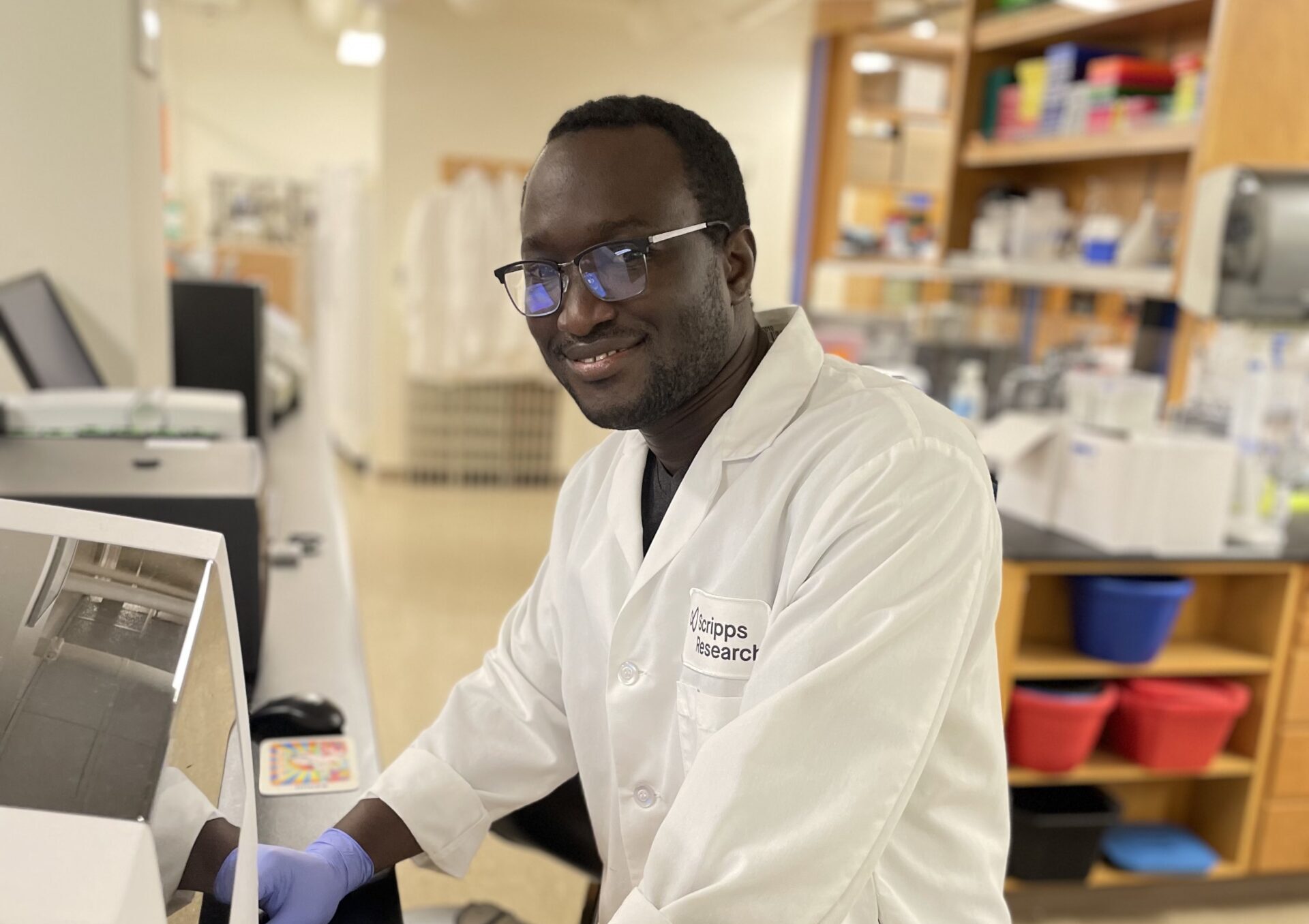We sat down with visiting PhD student John Demby Sandi on his last day at Andersen Lab to ask him about his three months spent at Scripps Research. Read about what he had to say about his experience:
Tell us a little bit about your PhD study.
I’m almost halfway through my PhD studies at the University of Ghana. Specifically, my PhD is on molecular and cell biology of infectious diseases. For my PhD thesis, I’m investigating the host factors in COVID-19 infection among West Africans. One of my objectives is to characterize the upper airway transcriptome profile in Ghanaians infected with COVID-19.
What made you decide to come to Scripps Research to conduct some of your research?
Scripps has a very good reputation, and most importantly we have a good collaborative relationship with the Andersen lab. In addition, I knew transcriptomic work could be best done using a highly sophisticated sequencing platform. This is currently lacking in most parts of Africa, creating a significant bottleneck to such research. Scripps has the NovaSeq, which is the most commonly used instrument for transcriptome analysis.
How did you decide on your subject of interest for your PhD project?
I have a background in viral genomic sequencing, and from this I realized I’m most driven toward understanding viral evolution. I also wanted to do something different. In the context of SARS-CoV-2, very little is known about host factors mediating COVID-19 clinical phenotypes in Africans compared to other populations. I saw a significant knowledge gap in the pathophysiology of SARS-CoV-2 in West Africans that I wanted to address.
How has your previous research both at Kenema Government Hospital and University of Ghana informed your current research?
As an emerging infectious disease scientist, I have frontline experience working on Lassa and Ebola viruses. I have leveraged the skills and knowledge I’ve gained over the years through designing and executing my current research. Particularly, my current work at Scripps is to do host RNA sequencing. Because I’ve been doing sequencing work since 2017, this makes adjusting to the new protocol a bit easier for me.
What types of samples did you work on while at Scripps?
I shipped cDNA samples generated from total RNA extracted from nasopharyngeal swabs to Andersen Lab. I focused on nasopharyngeal swabs because SARS-CoV-2 gains entrance into host cells primarily through the upper airway respiratory tract. Additionally, evidence suggests that the gene expression pattern in upper airway tissue has a downstream impact on COVID-19 clinical outcomes. For these reasons, nasopharyngeal samples are the best for characterizing the post-exposure transcriptome profile of COVID-19.
What have you found most informative from your experience at Scripps Research?
I joined the Andersen Lab with a lot of experience in wet lab work, which made the wet lab aspect of my research at Scripps very straightforward. I also knew coming here that I needed to gain skills in data analysis and build upon my bioinformatics skills. While at the Andersen Lab, I have gained knowledge in RNA sequencing data analysis and I have been exposed to a range of bioinformatics and data analysis tools, including R, which I hope to build on over time. I can best summarize my experience here as an eye-opener. Interacting with colleagues in the lab has significantly increased my interest in bioinformatic analysis and learning programming languages. I hope to further explore these areas concurrently with my studies.
What are the next steps in your research?
The next part of my project is to do functional assays. For instance, if gene A is significantly upregulated or downregulated in one group, we may want to know how that contributes to the disease progression of COVID-19 and the underlying molecular mechanism.
What areas of research do you hope to explore in the future after completing your PhD?
After my PhD, I want to push my career further forward by researching both endemic pathogens in Sierra Leone as well as emerging pathogens. Specifically, I want to continue working on Lassa virus and some flaviviruses.
Anything else you’d like to share about your time in San Diego and at Scripps Research?
The weather in San Diego is beautiful, and it didn’t differ too much from Africa. I’m glad to have gotten to see some of San Diego and the beaches while here. The funniest moment for me was when Josh took me to try Hawaiian poké for the first time at the Poké Shop in Pacific Beach. About five spoons in, I almost threw up! Definitely not for me!
I also had a chance to see the White House and the Lincoln Memorial in Washington D.C while traveling for the CREID annual meeting.
Overall, I’m very happy about my experience here. The folks in the lab have been very helpful. I was able to reach out with my questions on data analysis and everyone was willing to help. Through the support of everyone in the lab, I was able to accomplish my work.
I hope we stay in touch!


